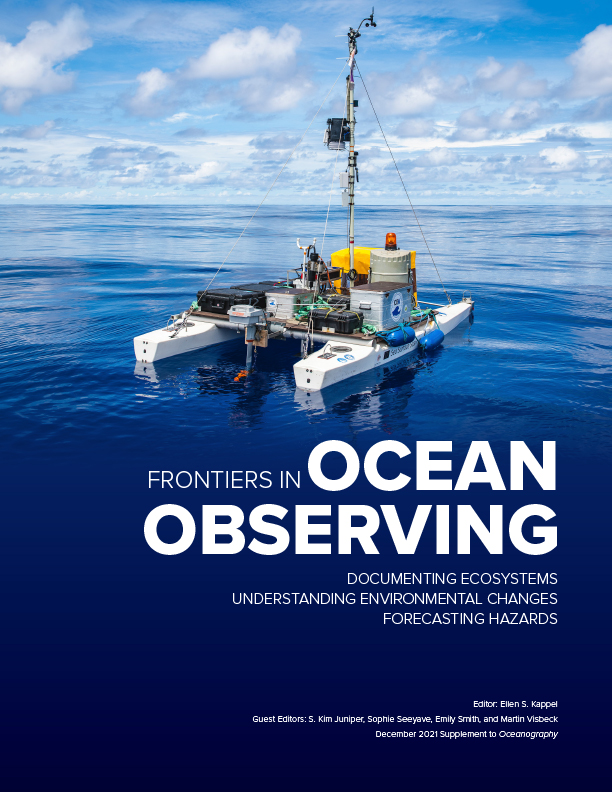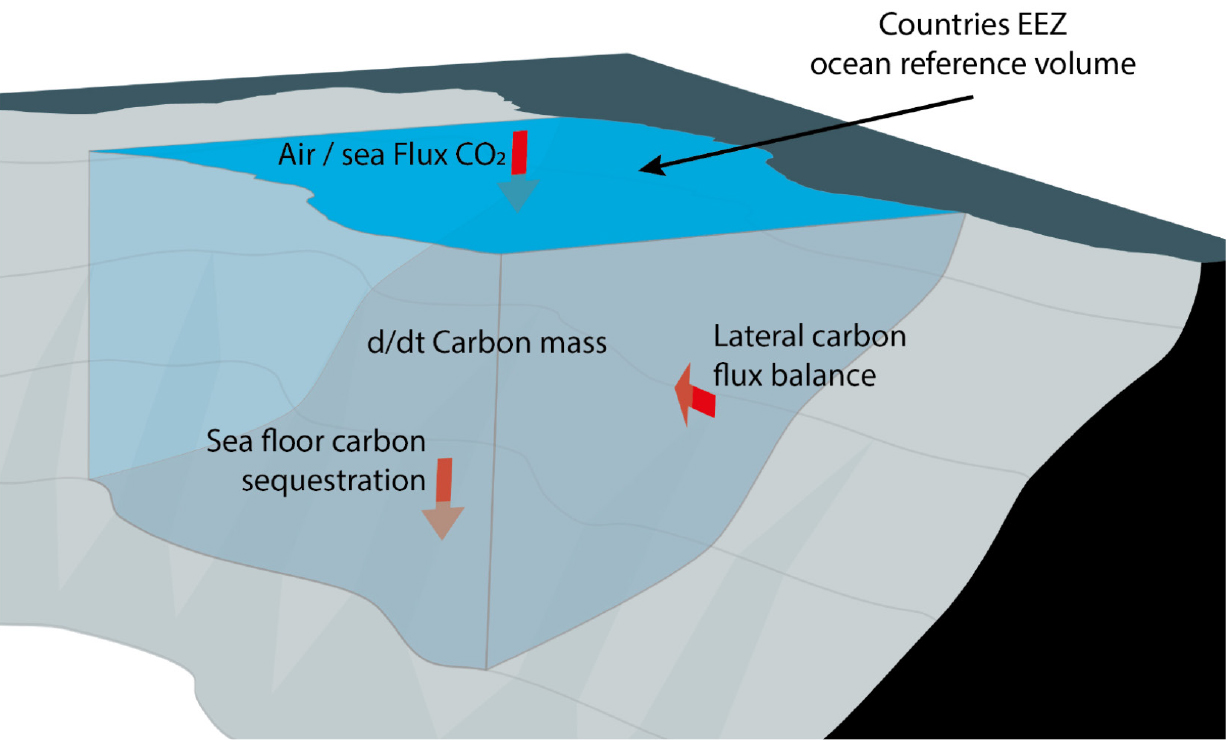Full Text
Signatory states to the Paris Agreement are required to formulate and implement national climate action (NCA) plans to direct their nationally determined contributions (NDCs) in reducing greenhouse gases (GHGs) and in particular carbon dioxide (CO2) emissions (UNFCCC, 2015). The NCA plans address CO2 management for all components of society, be it food, mobility, energy, or consumption. The extent to which NCA plans are in line with the overall targets will be assessed during global stocktakings, with the first one scheduled for 2023. Limiting global temperature increase by reducing GHG and CO2 emissions will depend crucially on natural, non-anthropogenic sink efficiency. The ocean currently removes 25%–30% of the CO2 emitted to the atmosphere by human activities (Friedlingstein et al., 2020), thereby providing, alongside other critical ecosystem services, an important societal wealth contribution via CO2 sequestration.
From the above results, it is obvious that the ocean CO2 monitoring system must be able to determine the present and future CO2 uptake with sufficient accuracy. To justify the effort involved, it is also useful to determine the monetary value of the oceanic sink. This can be done in three ways: a cost-benefit analysis (CBA), a cost-effectiveness analysis (CEA), or a market-based CO2 pricing approach. CBA and CEA both use shadow prices in their calculations that measure the social costs of emitting a marginal tonne of carbon1, whereas market prices are used in national accounting to compute, for example, the gross domestic product. In CBA, shadow prices are derived from estimates of costs of climate change impacts. In CEA, shadow prices are derived under a given target, such as a temperature target as defined in the Paris Agreement. Put simply, CBA provides information on how much wealth is generated by the ocean in terms of reducing climate change, and CEA provides information on how much wealth is generated by reducing emissions abatement costs for the given target. The latter information is in most cases more reliable and can also be obtained with a market-based approach, given the regulatory framework and that a market is in place. Observed CO2 prices can also be used to assess the value of CO2 sinks, even though these sinks are not involved in trading. The market and the underlying regulatory framework are ideally designed to regulate anthropogenic activities, so given natural CO2 sequestration, targets like net-zero CO2 can be achieved. However, a weakening of natural sinks implies, in turn, that faster reductions and additional atmospheric CO2 removal will be required. Similarly, the market price would increase given that a weakening of CO2 sinks is expected to be considered in the underlying regulatory framework, defining the scarcity in a given CO2 market.
Hence, highly reliable information about current and future ocean CO2 sinks provides value information for policymakers to properly align the regulatory framework, and for the business community to form realistic CO2 price expectations. Furthermore, CO2 sequestration by ocean sinks varies regionally—and 38% of the global ocean comprises territorial waters (Figure 1). Considering the regional variations in CO2 emissions and in sink activity implies that the CO2 wealth effects vary considerably for different countries (Bertram et al., 2021). Although regional differences in terrestrial CO2 sinks are considered in national emissions inventories, regional ocean sink contributions are not yet included in the determination of international burden sharing regarding CO2 emissions abatement. Thus, the current framework favors countries with large terrestrial CO2 sinks to the disadvantage of countries with large territorial ocean sinks. However, costs of ocean CO2 fluxes are highly interconnected: variability in the global ocean CO2 uptake of atmospheric CO2 will influence the CO2 uptake in territorial waters.
|
|
Therefore, improved and reliable estimates of ocean CO2 uptake are required to properly steer the ambitious levels included in the NDCs, to allow for improved burden sharing, to attribute territorial ocean CO2 uptake appropriately to countries, and to account for ocean carbon dioxide removal (CDR). Current scenarios still focus predominantly on terrestrial CDR, mostly because economic integrated assessment models are not yet capable of properly modeling ocean CDR. Given an increasing requirement for CDR due to the weakening of CO2 sinks, the necessary net CO2 emissions path is unlikely to be achievable without ocean CDR solutions, for example, ocean alkalinity management. However, properly assessing CDR via ocean-based measurements, which will be part of future NDCs, requires accounting for the feedback of territorial ocean CO2 uptake on global CO2 uptake.
In general, the assessment of ocean CO2 sequestration must be based on understanding the processes of and monitoring both fluxes and storage of CO2 in the ocean—from regional to global scales. The processes controlling CO2 in the ocean are often separated into “solubility pump” (controlled by physics and biogeochemistry) and “biological pump” (controlled by biochemistry and biology) concepts. However, these two pumps are interlinked via underlying processes and may also counteract each other in the matter of net CO2 uptake; for example, in highly productive upwelling regions, the CO2 sink created by the biological pump may compensate for the outgassing of CO2 driven by the solubility pump (Figure 2). Carbon assessments require determining the efficiency of both pumps and coordination of the underlying ocean observations that make use of multiple platforms (ships, underwater as well as surface autonomous vehicles, floats, moorings, and satellites) equipped with sensors and samplers employing a diverse pool of sensing technology (optical, particle probes, electrochemical) and operating at varying levels of technological readiness.
|
|
Data harmonization and quality control along with FAIR (Findable, Accessible, Interoperable and Reusable) access to data permit a wide spectrum of applications across disciplines and needs, and they must be ensured to enable integration of the various data streams into regional and global carbon products. Regional (and global) carbon data products with sufficient temporal and spatial resolutions are required for assigning values to Exclusive Economic Zone CO2 sinks. Global coordination of observational efforts, science approaches, and coordination with global syntheses are performed under the auspices of the International Ocean Carbon Coordination Project (IOCCP). A key aspect for use of data in the context of NCA plans is the global harmonization of error/uncertainties estimates that, for the ocean interior, are based on Reference Material (RM). In order to integrate the benefits of RM into a multiplatform observing system, a reference grid of long-term, sustained observations made using RM needs to be maintained. That in turn is used as a reference for secondary quality control of observations that do not allow direct RM traceability (e.g., expendable sensors or devices with exceptionally long endurance under harsh conditions and impacted by biofouling). IOCCP works directly with the Surface Ocean CO2 NETwork (SOCONET) and the Global Ocean Ship-based Hydrographic Investigations Program (GO-SHIP) to assure global coordination related to data quality standards and protocols. At a regional scale, the station labeling procedure of the Ocean Thematic Center (OTC) of the European Research Infrastructure Integrated Carbon Observation System-Ocean Thematic Centre (ICOS-OTC) is a prime example of successful implementation of data management procedures that result in delivery of high-quality information with known uncertainty. ICOS-OTC also focuses on other greenhouse gases, and the OTC maintains thematic centers to coordinate atmospheric and terrestrial domains to deliver sustained, truly integrated observations that benefit a variety of stakeholders.



